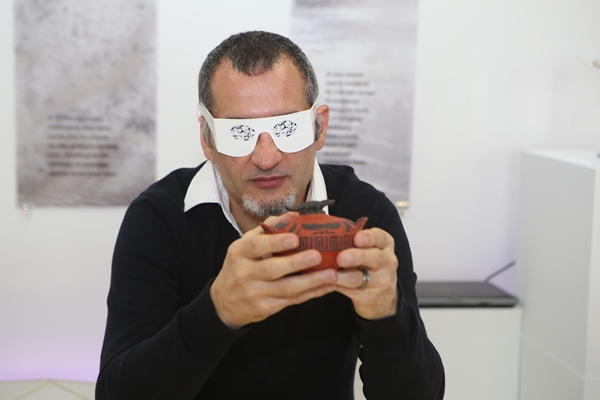Marcus Butler
7 August 2015: A visit to a museum allows most Australians to see beautiful art, interesting objects and interactive displays, but for those with blindness or vision impairment, the experience is limited.
University of Canberra PhD student Beaux Guarini’s research explores the ways that people who experience blindness or low vision wish to engage with museum and their collections.
Following the recent Mobile Makers forum and exhibition at the University, Mr Guarini has staged at a pop-in pop-up museum, using replica museum items which have been digitally designed and fabricated.
“I’ve been exploring some of the opportunities and constraints in creating replicas of museums exhibits through 3D printing, but these are items that people can handle and come to know in a very different way,” he said.
The museum space has welcomed guests with vision impairment and other attendees have been invited to wear glasses simulating a vision impairment to experience these items in the way a person with limited sight would.
The items include a copy of a 200-year-old Wedgwood sugar bowl, which features Ancient Egyptian-inspired motifs, such as gods in animal form including crocodiles and birds.
"The original sugar bowl was made from earthenware and was created by the famous Wedgwood company to commemorate a key British naval victory over the French in 1798," Mr Guarini said.
The version created for the pop-in pop-up museum has been 3D printed in polyamide (nylon plastic) and hand-painted using acrylic paints and sealed with a matt varnish.
Another of Mr Guarini's creations is a scaled down version of a Distler tin-plated toy car from 1930's Germany.
Both original items are held within the collection of the Powerhouse Museum | Museum of Applied Arts and Sciences in Sydney. The museum has scanned the items and freely offers the data to the public to recreate these items through digital fabrication.
Mr Guarini said he questions the ‘do not touch’ethos of many museums and galleries, but his work removes some concerns about people handling these objects.
“Barriers which may prevent museums from allowing people to handle these objects, whether based on concerns of fragility or rarity, don’t apply to a 3D printed replica. It means people can feel the features and create their own experience of it, without necessarily being able to see it.”
Australian museums have expressed an interest in Mr Guarini’s research, he’s working alongside a number of major institutions exploring how Australian museums can better accommodate the aspirations of people with vision impairment.
“I seem to be getting a call from a new museum every couple weeks which I take as a great sign that my research is going towards meeting a real-world need.”
“It’s important to remember that access means more than touching objects – we need to embrace all the senses. I want us to re-think how objects are displayed, introducing large print labels with good contrast, verbal descriptions of objects on display and audio descriptions of audio-visuals, can remove some of the barriers encountered by people with vision impairment,” Mr Guarini said.
Mr Guarini’s research is supported by the Faculty of Arts and Design and by the Centre for Creative and Cultural Research. Most of his participants are affiliated with the Royal Society for the Blind – Canberra Blind Society.



